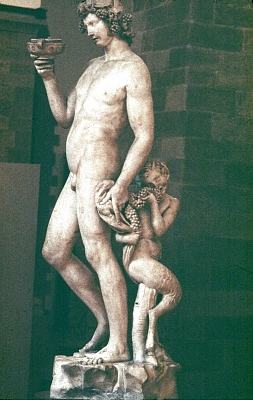

1. "Go Loudly, Pentheus" - Kathleen Raine
This poem is Raine's vision of Dionysos' reponse to Pentheus, who spoke disdainfully about the Bacchic rights. In it, Dionysos claims that Pentheus is ignorant of other beliefs and close-minded. He also threatens to punish Pentheus for his insolence.
Continue to analysis
2. "Bacchus" - Ralph Waldo Emerson
Emerson's poem praises wine and its many qualities, comparing it to various things, including music. The poem also calls upon Dionysos to "pour" more wine and bring forth its many pleasures.
Continue to analysis
3. Bacchus - Caravaggio

Bacchus c. 1597; Oil on canvas, 37 3/8 x 33 1/2 in; Uffizi, Florence
This portrait of Bacchus (Dionysos) features the deity robed in a toga and crowned in a wreath of grapes before a table full of fruit, including grapes and apples. He appears poised to drink from his glass of wine, which was poured from the pitcher of wine sitting before him on the table.
Continue to analysis
4. Bacchus - Michelangelo

Bacchus - Michelangelo, 1496-98
This nude statue of Bacchus shows the god of wine wearing a wreath of grapes and holding a goblet. He is also joined by a satyr who stands behind him and is eating grapes from his hand. Another detail of note is the animal face beneath the satyr's hooves.
5. Dance from Surfer at the River Styx - Twyla Tharp
Tharp's danced, which was choreographed for a play loosely based on Euripides' Bacchae. According to British newspaper The Guardian,"A chorus of black-costumed dancers move in formations of ritual aggression, their steps grotesquely inflected by images of mythological menace: hands like harpies' claws, faces bright with the drunken malevolence of satyrs, arms rippling darkly like the Styx itself."
Return to: CLA 1-216-05 home page
Last updated 23 October 05
c-ballard@cornellcollege.edu - a-piell@cornellcollege.edu - b-roush@cornellcollege.edu
Graphic on header from: artist4hire.net